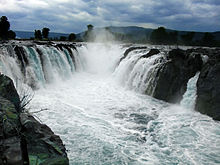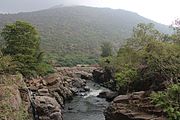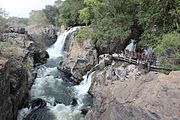| Revision as of 12:40, 25 February 2020 view sourceKSPRR (talk | contribs)139 editsNo edit summaryTags: Mobile edit Mobile web edit← Previous edit | Revision as of 14:22, 21 March 2020 view source C1MM (talk | contribs)Extended confirmed users12,343 edits Added galleryTag: Visual editNext edit → | ||
| Line 1: | Line 1: | ||
| {{pp-semi-sock|small=yes}} | {{pp-semi-sock|small=yes}} | ||
| {{Coordinate|NS=12.1182|EW=77.77385|format=decimal|type:landmark}} | |||
| {{Infobox waterfall | {{Infobox waterfall | ||
| | name = Hogenakkal Falls | | name = Hogenakkal Falls | ||
| | photo = Hogenakkal Falls Close.jpg | | photo = Hogenakkal Falls Close.jpg | ||
| | photo_caption = Hogenakkal Falls | | photo_caption = Hogenakkal Falls | ||
| | location = ] |
| location = ] and ] | ||
| | coords = {{coord|12.1192|77.7740|format=dms|type:landmark|display=inline}} | |||
| | elevation = {{convert|700|m|abbr=on}} | | elevation = {{convert|700|m|abbr=on}} | ||
| | type = | | type = | ||
| Line 16: | Line 16: | ||
| | world_rank = | | world_rank = | ||
| | website = | | website = | ||
| |map = India Tamil Nadu#India Karnataka | |||
| ⚫ | }} | ||
| |relief=yes|alt_name=Marikottayam}} | |||
| ⚫ | |||
| '''Hogenakkal''' is a ] in ] on the ] river |
'''Hogenakkal Falls''' is a ] in ] on the ] river on the border between ] of ] and ] of ].<ref>Upon entering Tamil Nadu, the Kaveri continues through a series of twisted wild gorges until it reaches Hogenakal Falls and flows through a straight, narrow gorge.... {{cite web|title=Kaveri River|url=http://www.britannica.com/EBchecked/topic/100477/Kaveri-River|work=Encyclopædia Britannica|accessdate=6 March 2012}}</ref><ref name=law> {{Webarchive|url=https://web.archive.org/web/20090409234827/http://lawmin.nic.in/ncrwc/finalreport/v2b3-6.htm |date=9 April 2009 }} ''Ministry of Law, Government of India''</ref><ref>{{cite web|url=http://tnmaps.tn.nic.in/blks_info.php?dcode=05&blk_name='Pennagaram'&dcodenew=9&drdblknew=3 |title=Taluk Information |publisher=Tnmaps.tn.nic.in |date= |accessdate=2008-11-07}}</ref><ref> {{webarchive|url=https://web.archive.org/web/20110721162222/http://www.tnpolice.gov.in/station_details.php?code=2958730&desc=HOGENAKKAL |date=21 July 2011 }}</ref><ref>{{cite web|url=http://india.gov.in/knowindia/st_tamilnadu.php |title=National Portal of India : Know India : State and UTs |publisher=India.gov.in |date= |accessdate=2008-11-07}}</ref><ref> Tamil Nadu Tourism development corporation</ref> It is located {{convert|127|km|abbr=on}} from ], {{convert|165|km|abbr=on}} from ], {{convert|147|km|abbr=on}} from ], {{convert|152|km|abbr=on}} from ] and {{convert|46|km|abbr=on}} from ].<ref></ref> Sometimes referred to as the "] of India," it is known for bathing areas and hired boat rides and as a major ]. ] rocks in this site are considered to be the oldest of its kind in South Asia and one of the oldest in the world.<ref>{{cite journal |id={{INIST|3910799}} |doi=10.1016/0301-9268(94)90104-X |title=2.0 Ga old pyroxenite-carbonatite complex of Hogenakal, Tamil Nadu, South India |year=1994 |last1=Natarajana |first1=M |last2=Bhaskar Rao |first2=B |last3=Parthasarathy |first3=R |last4=Kumar |first4=Anil |last5=Gopalan |first5=K |journal=Precambrian Research |volume=65 |issue=1–4 |pages=167–81}}</ref> The Government of Tamil Nadu made a proposal to convert the falls into providing drinking water for the state. | ||
| ==Etymology== | ==Etymology== | ||
| ⚫ | The word Hogenakkal is formed of two ] words ''hoge'' and ''kal''. When the water falls on the rocks it appears as if ''hoge'' (smoke) is emanating from the top of the ''kal'' (rock) because of the force of the water, hence ''Hogenakkal'' (smoking rocks).<ref name="kannada">{{cite web | ||
| ] | |||
| ⚫ | The word |
||
| |url=http://www.tamilnadutourism.org/places/citiestowns/Dharmapuri.aspx?CatId=C1&SubCat1Id=C1S1&SubCat2Id=C1S1S16 | |url=http://www.tamilnadutourism.org/places/citiestowns/Dharmapuri.aspx?CatId=C1&SubCat1Id=C1S1&SubCat2Id=C1S1S16 | ||
| |title=Dharmapuri district - places of interest | |title=Dharmapuri district - places of interest | ||
| Line 33: | Line 31: | ||
| {{main|Kaveri river}} | {{main|Kaveri river}} | ||
| The Kaveri is considered to form at ] in the ] in the ] of ] and gathers momentum as the land drops in elevation. It becomes larger as various tributaries feed into it on the way down.<ref name="law"/> At Hogenakkal, the Kaveri, now a large river, drops and creates numerous waterfalls as the water cuts through the rocky terrain. In places the water falls as much as {{convert|20|m|abbr=on}} and is said to sound like continual thunder.{{citation needed|date=July 2011}} |
The Kaveri is considered to form at ] in the ] in the ] of ] and gathers momentum as the land drops in elevation. It becomes larger as various tributaries feed into it on the way down.<ref name="law"/> At Hogenakkal, the Kaveri, now a large river, drops and creates numerous waterfalls as the water cuts through the rocky terrain. In places the water falls as much as {{convert|20|m|abbr=on}} and is said to sound like continual thunder.{{citation needed|date=July 2011}} The river carries ] which makes the downriver land fertile. | ||
| ⚫ | At Hogenakkal the river spreads out over a wide area of sandy beaches, then flows south to the ] and creates a {{convert|60|sqmi|km2|abbr=on}}. lake called ]. Built in 1934, this project improved irrigation and provided hydropower.<ref>{{cite web | ||
| ⚫ | |||
| ⚫ | At Hogenakkal the river spreads out over a wide area of sandy beaches, then flows |
||
| |url=http://www.cauvery.com/cauvery_river.html | |url=http://www.cauvery.com/cauvery_river.html | ||
| |title=Cauvery River in Southern India | |title=Cauvery River in Southern India | ||
| Line 44: | Line 41: | ||
| ==Weather== | ==Weather== | ||
| The best season to visit is soon after the monsoons, when the river is in full spate. But some tourists prefer to visit during off-season to skip the crowd. The temperature in summer varies between {{convert|23|-|34|°C|°F}} while during the winter it |
The best season to visit is soon after the monsoons, when the river is in full spate. But some tourists prefer to visit during off-season to skip the crowd. The water temperature in summer varies between {{convert|23|-|34|°C|°F}} while during the winter it ranges from {{convert|13|-|27|°C|°F}}.<ref>{{cite web|url=http://www.hogenakkal.com/services.html|title=Overview - Visit India Travel Guide Hogenakkal Adventure|last=|first=|date=|website=|publisher=Hogenakkal.com|accessdate=2014-02-07|url-status=dead|archiveurl=https://web.archive.org/web/20140224105605/http://www.hogenakkal.com/services.html|archivedate=24 February 2014|df=dmy-all}}</ref> | ||
| ==Boating== | ==Boating== | ||
| ⚫ | |||
| {{See also|Indian coracles}} | {{See also|Indian coracles}} | ||
| ] | ] | ||
| Boating in Hogenakkal is allowed during the dry-season as the |
Boating in Hogenakkal is allowed during the dry-season as the falls are not strong enough to disrupt the passage of the boats. This is the main source of income for boat operators. The coracles are about {{convert|2.24|m|abbr=on}} in diameter and can carry eight people at a time.<ref></ref> These coracles are made of ], and with all materials available takes about a day to build. The bottom of the boats are made waterproof by the use of ], but sometimes with sheets of plastic.<ref>{{cite journal |id={{INIST|13550447}} |doi=10.1080/02666030.2001.9628601 |title=Hide Boats at Hogenakal on the River Kaveri, Tamil Nadu |year=2001 |last1=Palmer |first1=Colin |last2=Blue |first2=Lucy |last3=McGrail |first3=Sean |journal=South Asian Studies |volume=17 |issue=1 |pages=199–207}}</ref> Use of plastics in the Hogenakkal vicinity, not just for boats, has been criticised due to problems with pollution.<ref></ref> These boats are steered and propelled using a single paddle, making them unique. The coracles are locally called ''parisal'' in ] and either ''teppa''<ref></ref> or ''harigolu'' in ]. | ||
| Freshly caught fish are sold by the gorge and also various vendors selling water and snacks up and down the gorge rowing their coracles is not uncommon. The fish caught include katla, robu, kendai, keluthi, valai, mirgal, aranjan and jilaby. After leaving the gorge, on the left shore one can find improvised stalls set up on the sand. There, one can let the fresh fishes be prepared in one of the many kitchens. Also, many people can be found swimming or bathing around there. | Freshly caught fish are sold by the gorge and also various vendors selling water and snacks up and down the gorge rowing their coracles is not uncommon. The fish caught include katla, robu, kendai, keluthi, valai, mirgal, aranjan and jilaby. After leaving the gorge, on the left shore one can find improvised stalls set up on the sand. There, one can let the fresh fishes be prepared in one of the many kitchens. Also, many people can be found swimming or bathing around there. | ||
| ⚫ | |||
| ==Hogenakkal water project== | ==Hogenakkal water project== | ||
| {{main|Hogenakkal Integrated Drinking Water Project}} | {{main|Hogenakkal Integrated Drinking Water Project}} | ||
| Hogenakal Falls<ref>{{Cite web|url=https://dharmapuri.nic.in/tourist-place/hogenakkal-falls/|title=Hogenakkal Falls|last=|first=|date=|website=dharmapuri.nic.in|url-status=live|archive-url=|archive-date=|access-date=24 December 2019}}</ref> is the location for the Hogenakkal Integrated Drinking Water Project proposed by the ].<ref></ref> The objective of this project is to provide safe drinking water to the urban and rural areas in Krishnagiri and Dharmapuri districts.<ref></ref> In February 2008, The Japan Bank for International Cooperation agreed to fund the Rs 1,340-crore project.<ref></ref> | Hogenakal Falls<ref>{{Cite web|url=https://dharmapuri.nic.in/tourist-place/hogenakkal-falls/|title=Hogenakkal Falls|last=|first=|date=|website=dharmapuri.nic.in|url-status=live|archive-url=|archive-date=|access-date=24 December 2019}}</ref> is the location for the Hogenakkal Integrated Drinking Water Project proposed by the ].<ref></ref> The objective of this project is to provide safe drinking water to the urban and rural areas in Krishnagiri and Dharmapuri districts.<ref></ref> In February 2008, The Japan Bank for International Cooperation agreed to fund the Rs 1,340-crore project.<ref></ref> | ||
| == Gallery == | |||
| {{Gallery | |||
| |title=Gallery | |||
| ⚫ | |File:Mountain near the hogenakkal falls.jpg | ||
| |Mountain near the hogenakkal falls | |||
| ⚫ | |File:Whirlpool damaged mountain portion in hogenakkal falls in tamil nadu.jpg | ||
| |Whirlpool damaged mountain portion in Hogenakkal Falls in Tamil Nadu | |||
| |File:HoggenekkalLandingParisalsPanorama2.jpg | |||
| ⚫ | |Area near Hogenakkal falls with the coracles beached for picnics | ||
| ⚫ | |File:Hogenakkal Falls bathing area.jpg | ||
| |Hogenakkal Falls bathing area | |||
| ⚫ | }} | ||
| ==See also== | ==See also== | ||
Revision as of 14:22, 21 March 2020
12°07′06″N 77°46′26″E / 12.1182°N 77.77385°E / 12.1182; 77.77385
Waterfall in Karnataka and Tamil Nadu| Hogenakkal Falls | |
|---|---|
| Marikottayam | |
 Hogenakkal Falls Hogenakkal Falls | |
  | |
| Location | Karnataka and Tamil Nadu |
| Elevation | 700 m (2,300 ft) |
| Longest drop | 20 m (66 ft) |
Hogenakkal Falls is a waterfall in South India on the Kaveri river on the border between Dharmapuri district of Tamil Nadu and Chamrajnagar district of Karnataka. It is located 127 km (79 mi) from Bangalore, 165 km (103 mi) from Kollegal, 147 km (91 mi) from Kolar, 152 km (94 mi) from Kolar Gold Fields and 46 km (29 mi) from Dharmapuri. Sometimes referred to as the "Niagara Falls of India," it is known for bathing areas and hired boat rides and as a major tourist attraction. Carbonatite rocks in this site are considered to be the oldest of its kind in South Asia and one of the oldest in the world. The Government of Tamil Nadu made a proposal to convert the falls into providing drinking water for the state.
Etymology
The word Hogenakkal is formed of two Kannada words hoge and kal. When the water falls on the rocks it appears as if hoge (smoke) is emanating from the top of the kal (rock) because of the force of the water, hence Hogenakkal (smoking rocks). It is also called as Marikottayam by the people of Tamil Nadu.
River
Main article: Kaveri riverThe Kaveri is considered to form at Talakaveri in the Brahmagiri hills in the Western Ghats of south India and gathers momentum as the land drops in elevation. It becomes larger as various tributaries feed into it on the way down. At Hogenakkal, the Kaveri, now a large river, drops and creates numerous waterfalls as the water cuts through the rocky terrain. In places the water falls as much as 20 m (66 ft) and is said to sound like continual thunder. The river carries sediment which makes the downriver land fertile. At Hogenakkal the river spreads out over a wide area of sandy beaches, then flows south to the Mettur Dam and creates a 60 sq mi (160 km). lake called Stanley Reservoir. Built in 1934, this project improved irrigation and provided hydropower.
Weather
The best season to visit is soon after the monsoons, when the river is in full spate. But some tourists prefer to visit during off-season to skip the crowd. The water temperature in summer varies between 23–34 °C (73–93 °F) while during the winter it ranges from 13–27 °C (55–81 °F).
Boating
See also: Indian coracles
Boating in Hogenakkal is allowed during the dry-season as the falls are not strong enough to disrupt the passage of the boats. This is the main source of income for boat operators. The coracles are about 2.24 m (7 ft 4 in) in diameter and can carry eight people at a time. These coracles are made of bamboo, and with all materials available takes about a day to build. The bottom of the boats are made waterproof by the use of hides, but sometimes with sheets of plastic. Use of plastics in the Hogenakkal vicinity, not just for boats, has been criticised due to problems with pollution. These boats are steered and propelled using a single paddle, making them unique. The coracles are locally called parisal in Tamil and either teppa or harigolu in Kannada.
Freshly caught fish are sold by the gorge and also various vendors selling water and snacks up and down the gorge rowing their coracles is not uncommon. The fish caught include katla, robu, kendai, keluthi, valai, mirgal, aranjan and jilaby. After leaving the gorge, on the left shore one can find improvised stalls set up on the sand. There, one can let the fresh fishes be prepared in one of the many kitchens. Also, many people can be found swimming or bathing around there.
Hogenakkal water project
Main article: Hogenakkal Integrated Drinking Water ProjectHogenakal Falls is the location for the Hogenakkal Integrated Drinking Water Project proposed by the Tamil Nadu Government. The objective of this project is to provide safe drinking water to the urban and rural areas in Krishnagiri and Dharmapuri districts. In February 2008, The Japan Bank for International Cooperation agreed to fund the Rs 1,340-crore project.
Gallery
Gallery-
 Mountain near the hogenakkal falls
Mountain near the hogenakkal falls
-
 Whirlpool damaged mountain portion in Hogenakkal Falls in Tamil Nadu
Whirlpool damaged mountain portion in Hogenakkal Falls in Tamil Nadu
-
 Area near Hogenakkal falls with the coracles beached for picnics
Area near Hogenakkal falls with the coracles beached for picnics
-
 Hogenakkal Falls bathing area
Hogenakkal Falls bathing area
See also
References
- Upon entering Tamil Nadu, the Kaveri continues through a series of twisted wild gorges until it reaches Hogenakal Falls and flows through a straight, narrow gorge.... "Kaveri River". Encyclopædia Britannica. Retrieved 6 March 2012.
- ^ ARTICLE 262 AND INTER-STATE DISPUTES RELATING TO WATER Archived 9 April 2009 at the Wayback Machine Ministry of Law, Government of India
- "Taluk Information". Tnmaps.tn.nic.in. Retrieved 7 November 2008.
- Station Details Archived 21 July 2011 at the Wayback Machine
- "National Portal of India : Know India : State and UTs". India.gov.in. Retrieved 7 November 2008.
- Dharmapuri district Tamil Nadu Tourism development corporation
- Tamil Nadu tourism
- Natarajana, M; Bhaskar Rao, B; Parthasarathy, R; Kumar, Anil; Gopalan, K (1994). "2.0 Ga old pyroxenite-carbonatite complex of Hogenakal, Tamil Nadu, South India". Precambrian Research. 65 (1–4): 167–81. doi:10.1016/0301-9268(94)90104-X. INIST 3910799.
- "Dharmapuri district - places of interest". tamilnadutorism.org. Retrieved 11 November 2006.
- "Cauvery River in Southern India". cauvery.com. Retrieved 11 November 2006.
- "Overview - Visit India Travel Guide Hogenakkal Adventure". Hogenakkal.com. Archived from the original on 24 February 2014. Retrieved 7 February 2014.
- The Hindu - Row, row, row your boat
- Palmer, Colin; Blue, Lucy; McGrail, Sean (2001). "Hide Boats at Hogenakal on the River Kaveri, Tamil Nadu". South Asian Studies. 17 (1): 199–207. doi:10.1080/02666030.2001.9628601. INIST 13550447.
- Garbage ruining Hogenakkal's beauty - The Hindu
- Hogenakkal falls
- "Hogenakkal Falls". dharmapuri.nic.in. Retrieved 24 December 2019.
{{cite web}}: CS1 maint: url-status (link) - The Hindu - The 1998 story of Hogenakkal
- Times of India - Hogenakkal project: Water of hope
- Business Line - Japan Bank agrees to fund Hogenakkal water project
External links
| Kaveri basin | |
|---|---|
| Riparian states/UT | |
| Tributaries | |
| Distributaries | |
| Dams | |
| Waterfalls and lagoons | |
| Geographical features | |
| Bridges | |
| Cities and towns |
|
| Islands | |
| Related | |
Categories: